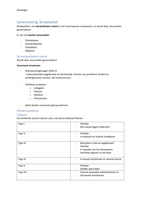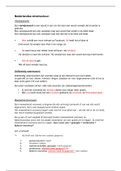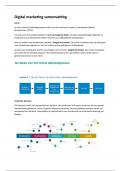Topic Always Connected: Key insights in youth, media and technology
Inhoudsopgave
Week 1: Introduction: Youth, Media and Technology.....................................................................................2
Main course content.............................................................................................................................................2
Media theory THEN and NOW..............................................................................................................................3
Topic in the Spotlight: Screen time.......................................................................................................................4
Week 2: Developmental psychology meets Media: from infancy to adolescence............................................6
Development from infancy to middle childhood & media preferences................................................................6
Development of adolescents & media preferences..............................................................................................7
Topic in the Spotlight: Brain development of adolescents and media use (Crone & Konijn)..............................11
Week 3: Always Educated: Educational media, incl. television, games and VR..............................................14
Gaming motivations............................................................................................................................................14
Gaming effects....................................................................................................................................................16
Educational media: Theory & Evidence..............................................................................................................18
Educational media: Beyond theory & evidence (Three Cs).................................................................................22
Topic in the Spotlight: Virtual Reality as learning tool and Kids.........................................................................22
Week 4: Always Connected: Opportunities and risks of social media............................................................25
Social media & childhood....................................................................................................................................25
Social media & adolescence................................................................................................................................28
Social media & adolescence, well-being and the state of the research on this topic.........................................30
Topic in the Spotlight: Social media & body image............................................................................................33
Topic in the Spotlight: Screen use and ADHD.....................................................................................................37
Topic in the Spotlight: Media multitasking. How does it affect attention, social well-being and sleep?...........39
Topic in the Spotlight: Addiction to technology..................................................................................................42
Week 6: Always Accompanied: Media representation and identity development.........................................43
Introduction.........................................................................................................................................................43
Topic in the Spotlight: Gender & stereotyping....................................................................................................44
1
, Topic in the Spotlight: Ethnicity & identification................................................................................................45
Week 7: Always in Progress: The future of media and tech and how to successfully navigate a world that is
always connected........................................................................................................................................ 46
Solutions for technology challenges regarding children & adolescents.............................................................46
Week 1: Introduction: Youth, Media and Technology
Main course content
General developmental stages: every age group has specific developmental characteristics
Early childhood Middle childhood Adolescence
Infants (0 – 2) (Early) middle childhood (5 – 8) Specific: early (12 – 14), middle (14 –
15), late (16 – 19)
Toddlers (2 – 4) Tweens (8 – 12) Broad: Adolescence (12 – 19)
Preschoolers (4 – 5)
Kids and youth entertainment landscape is changing rapidly. We do not just have YouTube and Netflix, but we
have YouTube-Kids and Netflix-Kids. The toys that kids play with nowadays (tech-toys), are way different than
the toys that we played with (wooden train).
Kids and youth education is also changing. The classroom setting is changing: from paper and pen, to big old
computers, to every child with their own laptop, to VR. Augmented reality: will this make our education better?
Will technology mean that we get better educated kids or is it only a distraction? The combination of ‘kids and
iPads’ got a lot of attention, because iPads are very user-friendly: in comparison to moving around with a mouse,
using an iPad is super accessible for kids with a really young age.
Big companies have their eyes set on classrooms and are trying to get into the educational space: namely
companies like Apple, Nintendo, Microsoft and Google.
- Apple’s got a new plan to bring creativity (and more iPads) to schools
- Nintendo is bringing its Switch and Labo platforms to classrooms across the country
- Microsoft’s Showcase Schools Program (Africa) aims to change classrooms by 2030.
- Google is trying to get into that market by sponsoring schools by getting them cheap equipment. Also,
google has tons of free software available for schools.
The influence of Media and technology on identity, well-being and relationships.
We see a lot of negativity: ‘Technology! It’s destroying our youth!’ It says that it is making our youth more
narcissistic and materialistic.
- Cyberbullying gets a lot of attention, since it is one of the worst situations in Finland.
- Teen sexting has become even more common than ever. Is that a problem? Or is it part of normal
development?
We are not only talking about technology and social media: we also have a lot of discussions about traditional
media. ‘13 Reasons Why’ on Netflix about suicides brought up a lot of discussions about whether suicide and
these characters were being glamorized or presented in such a way that suicide became an attractive option for
teens who are struggling. Creating (entertainment) narratives to help people is a skill. Something that they could
have avoided (these discussions) if they would have looked at the literature that is available.
Is there anything positive out there? YES
- When iPads are used in a specific way, it can improve reading attraction abilities: ‘Texts and tablets
more than double time parents spend reading to kids’
2
, - Discussions about how technology can be used in specific populations to make their lives better:
‘GoFAR Improves Social Skills for Autistic Kids Using Google Glass’ and ‘This App Is Helping Syrian
Refugees Learn to Read’
This is a difficult population to talk about, to research and to please, because young people are really fickle: they
change their mind quickly. However, it is a lucrative market. Companies are really keen to appeal to this
audience. Facebook is seeing young people leaving their platform, so they try to change it in order to be more
attractive for youth. Snapchat is trying to get kids brands to engage with this platform. Netflix is investing a lot
in their kids portfolio.
Media theory THEN and NOW
Thinking about the role of media and technology: THEN
Most of the studies that are conducted looked at media exposure on one side and its outcome on the other side.
We expect these two to be related. It is the idea that all of us are affected by media to the same extend all the
time. That was expired by the early media experiences. The Hypodermic Needle Perspective argues that media
effects were immediate, direct, and the same for everyone. So, if all students of this class would go and see the
same horror movie, they would all experience it in the same way. However, we would probably all disagree.
The first studies that looked at kids and media are from the end of the 20s. This was when the first talkies came
out. Talkies were movies about gangsters. Gangsters were presented as glamorous people and something to be
aspired to. People were concerned that young people who went to cinemas and see these talkies would be aspired
to adapt to a gangster life. Pretty similar to the concerns we have today.
Payne Fund Studies (interest in youth and media effects): there were several studies that looked at how children
at the time were affected by these movies. They provided the first evidence that there is something called a
media effect.
Thinking about the role of media and technology: NOW
Contemporary thinking about media and tech
- Academics: Differential Susceptibility to Media Effects Model (DSMM). This argues that we are all
differently affected, because we are all (individually) different!
- Practitioners: The Three Cs (Child, Content and Context) if you would explain the DSMM to
someone, use this Three Cs approach!
These two models (DSMM and Three Cs) are not separate from each other, they overlap!
Lisa Guernsey from the Early Education Initiative on the Three Cs approach
Parents often struggle with the question of how long they should let their kids look at a screen. It is in a lot of
parents’ minds, since it is quite new. The parents themselves did not have screens growing up. What we know
from science is that there is more to it than the time children spend watching screens. We have to start answering
questions about the Three Cs:
- Child: the individual child’s needs (every child is different)
- Content: what is the content that is on the screen? What is the child watching?
- Context: who is sitting with the child? How is it embedded in their daily routine?
Differential Susceptibility to Media Effects Model (DSMM) (Valkenburg & Peter, 2013).
What the model says is that media use has certain effects. But we are not all using the same type of media.
Differences between people can be attributed to dispositional differences (personality), developmental
differences (related to age) or they can be attributed to social context (your peer group/parents/culture) all of
these determine what type of media you are drawn to. This is shown with the orange lines. Then it says, if people
are different from each other, then they are also differently affected. That is why they draw the green line. So,
media use on media effect is different for these different people. One of the ways that we explain effects is
because we respond to it. If you are playing a video game and afterwards you might act a little bit more
aggressively to your parents, it might be because you are completely immersed into the game and feel physically
aroused through playing this video game. Consequently, you are already tensed which makes it more likely that
3
, you react aggressively. You have to think about these underlying responses: how do you actually feel when you
are consuming media? This is shown with the blue line. So, now we have content, context and the child.
The Three
Cs
(Guernsey, 2012): ‘Should I let my child play the app …?’
- Child: how old is your child? Does your child have attention problems already?
- Content: carefully assess app content, is it educational, age appropriate, etc.?
- Context: will you and your child use the app together, or will your child use it alone?
The answers to these three questions will help you answer the one question above.
What is really important, is if you have this model and if you are trying to understand this model, it is easiest to
start with applying it to your own situation. When you open your Netflix account, you will be provided with
content. You will be focusing your content depending on what you just talked about with your friends.
It all depends on what your experiences are and who you are as a person. Then everyone will be differently
affected when watching the same show (e.g., Grey’s Anatomy):
- Behavior: applying to med school/ going to see a doctor
- Knowledge: knowledge about medical problems
- Attitudes/beliefs: towards female surgeons
- Emotions: feelings entertained/excited/sad/scared
Topic in the Spotlight: Screen time
What exactly are we talking about when we are talking about screen time? Look at the screens that children have
available and look at what infants use. Data from the Pew Research Center from 2020 show that even infants
already, and young children even more so, have a lot of screens available. So, what is it exactly if we are talking
about screen time these days?
Parents are worried about their children’s screen time and seek advice.
How did the concern about screen time start?
It really started with Commercial TV in the 70s and 80s. But, with commercial TV, it also meant programs and
advertisements directed at younger audiences. Always when a new technology is introduced and it seems to (or
may) affect children, society will get worried. This was true with radio, regular tv, basically really any
technology. But then, other things happened. The Teletubbies started in 1997 and became a really popular show
and what we refer to as the Diaper Demographic. Diaper Demographic: these shows were directed at the very,
very young (what we would call infancy). That really worried a lot of people. Diaper Demographic shows:
Teletubbies (1997), Baby Einstein (popular from 2001 when Disney took over the show) and Baby TV (popular
from 2005 Fox International Channels)
American Association of Pediatrics (AAP) felt it had to come with some advice (2001):
- Watch nothing at all if you are < 2 years. Parents, do not let your kid watch anything for the following
reason: kids at that age will learn most from interacting with caregivers, being outside, exploring,
experiencing, touching things, feeling, learning how to move their bodies and watching/sitting behind a
screen is not helping that.
- They also had advice for older kids. 2 to 5-year-olds: 1-hour screen time per day. And > 6-year-olds:
place limits on screen time to ensure sleep and physical activity.
4











